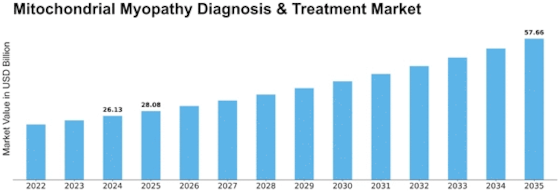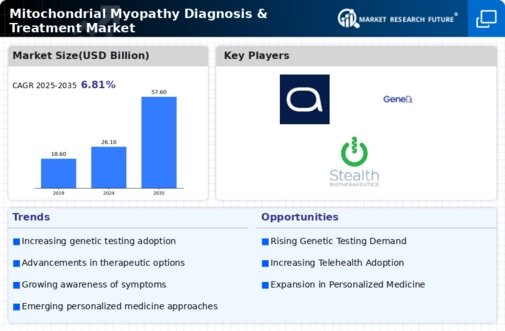Mitochondrial Myopathy Diagnosis Treatment Size
Mitochondrial Myopathy Diagnosis & Treatment Market Growth Projections and Opportunities
Mitochondrial myopathy is a rare genetic disorder characterized by mitochondrial dysfunction, resulting in muscle weakness, fatigue, and other debilitating symptoms. As medical understanding of this condition continues to evolve, the market for diagnosing and treating mitochondrial myopathy has gained traction. This research report aims to provide a detailed analysis of the market size, trends, key players, challenges, and opportunities within the Mitochondrial Myopathy Diagnosis & Treatment Market.
Market Overview: The market for diagnosing and treating mitochondrial myopathy has witnessed steady growth due to increasing awareness, advancements in diagnostic technologies, and a growing patient pool. As per recent studies, the prevalence of mitochondrial myopathy is relatively low, affecting approximately 1 in 5,000 individuals globally. However, the rise in reported cases and improved diagnostics has augmented market growth prospects.
Diagnosis Landscape: Accurate diagnosis remains a significant challenge in managing mitochondrial myopathy due to its complex clinical presentation and overlapping symptoms with other neuromuscular disorders. However, advancements in genetic testing, muscle biopsies, biochemical assays, and imaging techniques such as MRI have significantly improved diagnostic capabilities. The market for diagnostic tools and assays is expected to expand further with ongoing research into biomarkers and non-invasive testing methods.
Treatment Landscape: Treating mitochondrial myopathy poses challenges as there is no definitive cure. Current treatments primarily focus on symptom management, aiming to improve quality of life for patients. Therapeutic interventions often involve a multidisciplinary approach, including physical therapy, exercise regimes, dietary modifications, and supplements targeting mitochondrial function. Moreover, research into potential targeted therapies, gene therapies, and mitochondrial replacement techniques is underway, holding promise for future treatment avenues.
Market Dynamics: Several factors contribute to the growth of the Mitochondrial Myopathy Diagnosis & Treatment Market. These include increased research funding, collaborations between pharmaceutical companies and research institutions, a deeper understanding of mitochondrial biology, and a rising demand for personalized medicine approaches. Additionally, the emphasis on rare disease awareness and supportive government initiatives are driving market expansion.
Key Players: The market comprises both established pharmaceutical companies and emerging biotech firms actively involved in developing diagnostic tools, therapies, and treatment modalities for mitochondrial myopathy. These include but are not limited to Stealth BioTherapeutics, Khondrion, NeuroVive Pharmaceutical, and Mitobridge (a subsidiary of Astellas Pharma). Partnerships, mergers, and acquisitions within the industry are expected to further fuel market growth.
Challenges and Opportunities: Despite the progress in research and development, the Mitochondrial Myopathy Diagnosis & Treatment Market faces challenges such as high treatment costs, limited therapeutic options, and regulatory hurdles in drug development. However, advancements in precision medicine, gene editing technologies like CRISPR-Cas9, and ongoing clinical trials offer significant opportunities for market expansion and innovation.
Conclusion: In conclusion, the Mitochondrial Myopathy Diagnosis & Treatment Market shows substantial potential for growth due to increased awareness, technological advancements, and ongoing research endeavors. The market's trajectory is poised to be shaped by innovative diagnostic tools, novel therapeutic approaches, and collaborative efforts among stakeholders to address the unmet needs of patients with mitochondrial myopathy.


















Leave a Comment